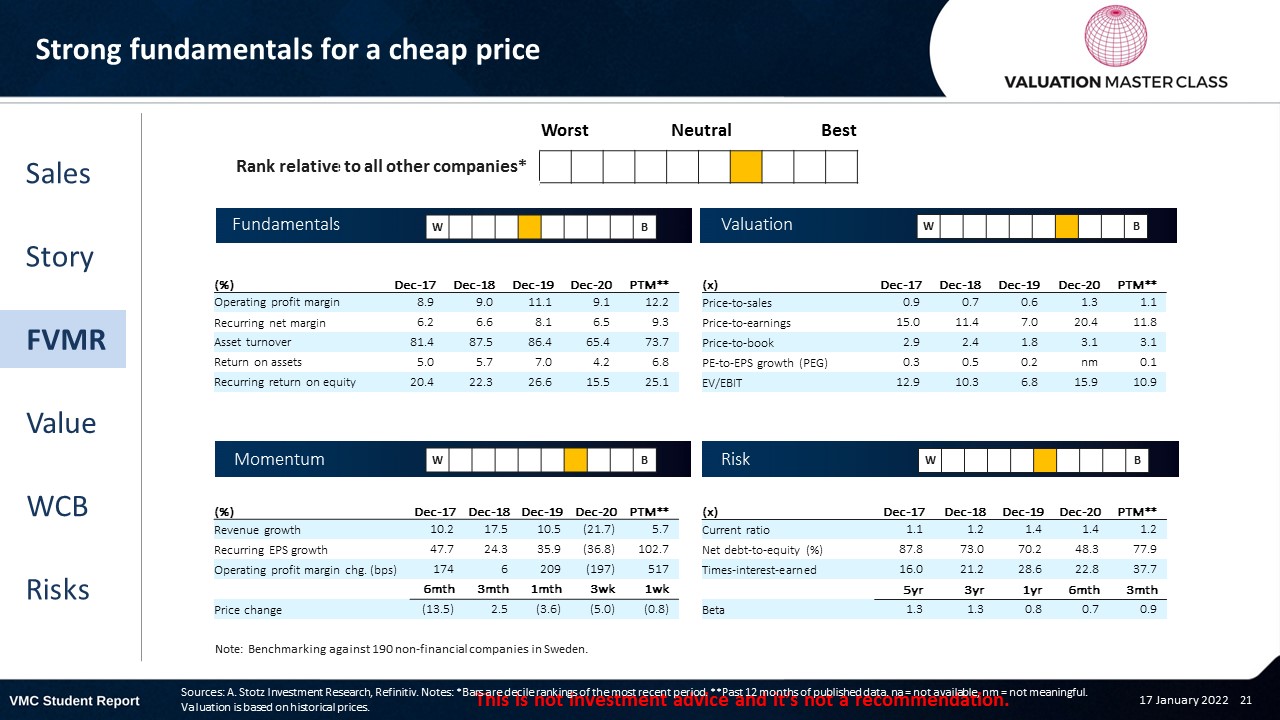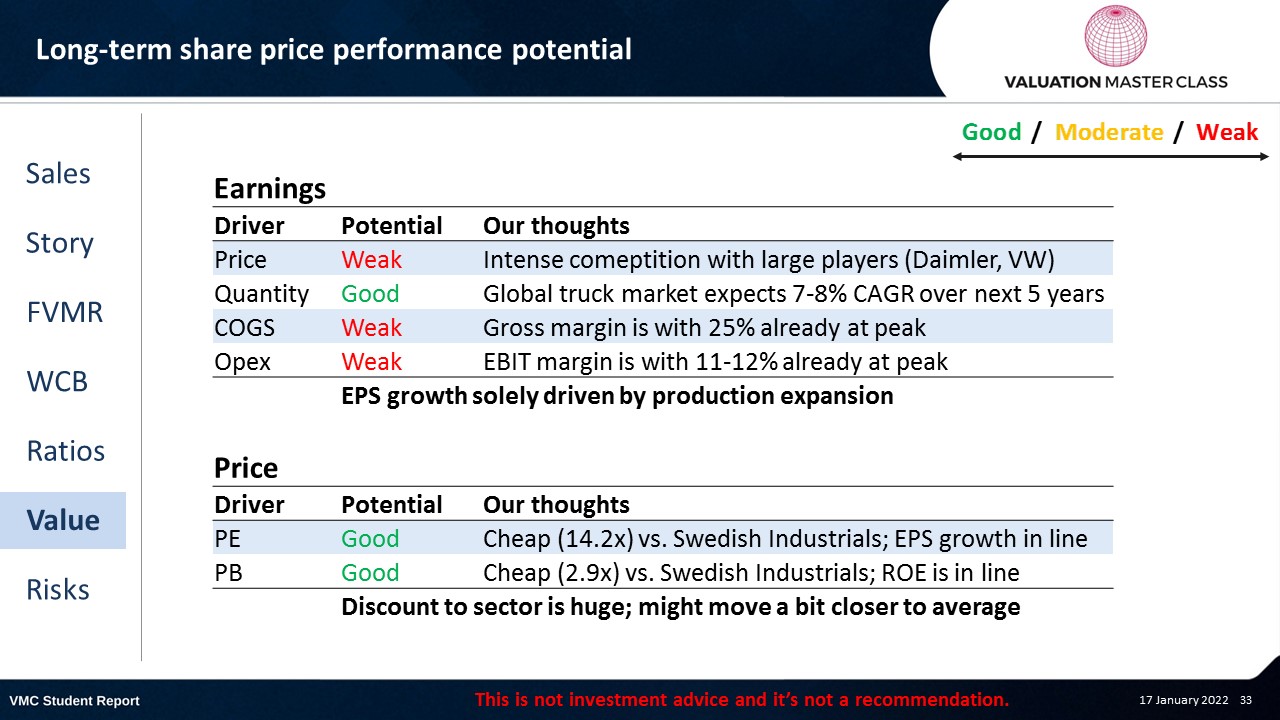Has Volvo’s Strong Value Creation Been Overlooked by the Market?
Value play with strong dividend growth potential
The post was originally published here.
Highlights:
- Acquisition in China to ride demand wave
- Consistent value addition through strong profitability
- Leading role in EV and hydrogen to reclaim market share
Download the full report as a PDF
Price on the way to turn bullish, volume signal unclear
- In 2H21, the 50 DMA has mainly stayed below the 200 DMA
- However, most recently, the 50 DMA started to rise, and it seems like it can cross the 200DMA very soon
- If the 50 DMA-line were to continue to rise, we would consider it a bullish signal
- The RSI-Volume recently converged to the 50%-line which, if continues, would also be a positive sign
Volvo’s revenue breakdown 9M21
Acquisition in China to ride demand wave
- China is by far the strongest and fastest-growing market for heavy duty trucks in the world
- It is the primary market for the company to realize future growth opportunities
- Instead of exporting to China, Volvo aims to ramp up sales by establishing a production site in the country
New production site adds 7% capacity
- Volvo confirmed its plan to acquire JMC Heavy Duty Vehicle which owns a manufacturing site in Taiyuan, China
- The acquisition accumulates to SEK1.1bn
- With the acquisition, Volvo aims to ramp up its sales in China
- It adds 15,000 trucks to Volvo’s capacity
- As a comparison, in 2020, Volvo delivered 4,500 trucks to China
Consistent value addition through strong profitability
- Volvo’s impressive ROIC is attributable to its specialization in high-margin trucks and construction equipment
- Volvo sold its passenger vehicles unit in 1999 as the synergies between commercial and passenger vehicles were low
- Since 2021, Volvo Car is a separate listed entity under majority control of Geely
- Volvo’s biggest competitor Daimler followed a similar strategy by spinning-off its truck segment in January 2022
What happens to a company’s ROIC over time?
Leading role in EV and hydrogen to reclaim market share
- Over the past 5 years, Volvo has lost market share in its most important regions
- Still, its early shift toward pure EV vehicles could help to regain its market share over the long run
- The company is also betting on hydrogen which could be more suitable for trucks due to its long-distance ability
- Strategic partnerships with Daimler (largest truck manufacturer) could lead to a more concentrated industry
FVMR Scorecard – Volvo
- A stock’s attractiveness relative to stocks in that country or region
- Attractiveness is based on four elements
- Fundamentals, Valuation, Momentum, and Risk (FVMR)
- Scale from 1 (Best) to 10 (Worst)
Consensus remains cautious but sees upside
- 17 analysts expect the company to outperform while 9 analysts still stay cautious
- Analysts expect strong revenue growth in the next two years, but might be too pessimistic in 23E
- Given that the global truck segment is expected to grow by 7-8% until 25E, I believe that Volvo can maintain a growth rate above 5%
Get financial statements and assumptions in the full report
P&L – Volvo
- Net profit sees a strong rebound in 21E and could exceed its pre-pandemic level in 22E
- The strong bottom-line is mainly driven by the margin expansion, but also strong growth prospects
Balance sheet – Volvo
- Net assets have fallen in 2020 after selling UD truck segment to Isuzu Motors
- However, increased CAPEX for capacity expansion and battery development lead to increase in net fixed assets again
- The company is moderately leveraged
- In 2020, its net-debt to equity ratio stood at 0.9x
Cash flow statement – Volvo
- Strong operating cash flow allows the company to resume its dividend payments in line with its pre-pandemic policy
- I expect dividend yield over the near-term to range between 2.5-3.5%
Ratios – Volvo
- After the revenue rebound in 22E, we assume revenue growth to normalize
- Beyond 2022, I see a healthy annual revenue growth potential around 5%
- EBIT margin expansion in 21E likely to stay
- This helps Volvo to be among the most profitable trucks manufacturer
Long-term share price performance potential
Free cash flow – Volvo
- Strong cash flow generation is crucial for returning dividends to shareholders
Value estimate – Volvo
- I see a slightly higher revenue growth than consensus
- Tapping further into the Chinese market could constitute a catalyst for the share price
- Truck market has favorable growth prospects
World Class Benchmarking Scorecard – Volvo
- Identifies a company’s competitive position relative to global peers
- Combined, composite rank of profitability and growth, called “Profitable Growth”
- Scale from 1 (Best) to 10 (Worst)
Key risk is intensified competition in local markets
- Adverse regulatory environment in China could hamper business
- Underestimating smaller local competitors could make expansion difficult
- Failure to keep up with technological shift to long-distance EV vehicles
Conclusions
- Riding demand wave in China is biggest potential for growth
- Fast adaption to EV and hydrogen give it a timing advantage in the market
- Industry-leading ROIC, but still trading at a discount
Download the full report as a PDF
DISCLAIMER: This content is for information purposes only. It is not intended to be investment advice. Readers should not consider statements made by the author(s) as formal recommendations and should consult their financial advisor before making any investment decisions. While the information provided is believed to be accurate, it may include errors or inaccuracies. The author(s) cannot be held liable for any actions taken as a result of reading this article.











